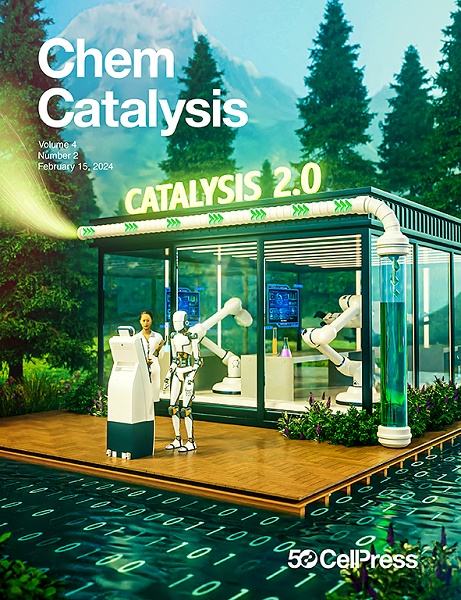Oxygen-vacancy-mediated photocatalytic activity of antimony molybdenum oxide toward green ammonia synthesis
IF 11.6
Q1 CHEMISTRY, PHYSICAL
引用次数: 0
Abstract
Oxygen vacancies in metal oxide photocatalysts are essential to activate photocatalytic activity toward nitrogen fixation, although their roles and underlying mechanisms remain poorly understood. Unfortunately, oxygen vacancies are prone to disappear during photocatalysis processes. Herein, antimony molybdate (Sb2MoO6) is proposed as a photocatalyst for green ammonia synthesis, which achieves ammonia generation rate of 6.39 μM h−1⋅g−1. Oxygen vacancies modulate the MoO6 octahedra, not the tetrahedral, SbO4 bilayers in the triclinic structure of Sb2MoO6 and result in partial reduction of Mo6+ to Mo5+. Instead of oxygen vacancies themselves, Mo5+ serves as active sites, favoring surface adoption of N2 and formation of reaction intermediates. Oxygen vacancies are predominantly refilled over extended photocatalysis, leading to conversion of Mo5+ back to Mo6+ and consequent photocatalyst deactivation. Therefore, cobalt dopant is introduced to stabilize the oxygen vacancies effectively. The scientific insights obtained will guide the development of stable photocatalysts for green ammonia synthesis.

氧空位介导的氧化锑钼光催化活性在绿色氨合成中的应用
金属氧化物光催化剂中的氧空位是激活固氮光催化活性所必需的,尽管它们的作用和潜在机制尚不清楚。不幸的是,在光催化过程中,氧空位很容易消失。本文提出钼酸锑(Sb2MoO6)作为绿色合成氨的光催化剂,其合成氨速率为6.39 μM h−1⋅g−1。氧空位在Sb2MoO6的三斜结构中调节MoO6八面体,而不是四面体SbO4双分子层,导致Mo6+部分还原为Mo5+。Mo5+不是氧空位本身,而是作为活性位点,有利于N2的表面吸附和反应中间体的形成。在扩展光催化过程中,氧空位主要被重新填充,导致Mo5+转化回Mo6+,从而导致光催化剂失活。因此,引入钴掺杂剂可以有效地稳定氧空位。所获得的科学见解将指导绿色合成氨稳定光催化剂的开发。
本文章由计算机程序翻译,如有差异,请以英文原文为准。
求助全文
约1分钟内获得全文
求助全文
来源期刊
CiteScore
10.50
自引率
6.40%
发文量
0
期刊介绍:
Chem Catalysis is a monthly journal that publishes innovative research on fundamental and applied catalysis, providing a platform for researchers across chemistry, chemical engineering, and related fields. It serves as a premier resource for scientists and engineers in academia and industry, covering heterogeneous, homogeneous, and biocatalysis. Emphasizing transformative methods and technologies, the journal aims to advance understanding, introduce novel catalysts, and connect fundamental insights to real-world applications for societal benefit.

 求助内容:
求助内容: 应助结果提醒方式:
应助结果提醒方式:


